History of the Observatory
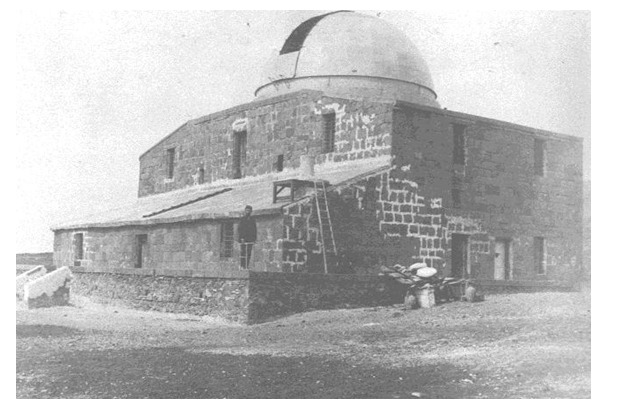
The old etnean “Vincenzo Bellini” observatory.
In 1876, during a solemn Academy Gioenia meeting, on the suggestion of the astronomer Pietro Tacchini from Modena, the project for the construction of an Observatory dedicated to Physical Astronomy, to be entitled to Vincenzo Bellini, was approved. Just in that year in fact, the body of the musician from Catania was moved from Paris to the cathedral of Catania.
Pietro Tacchini, at the time assistant astronomer at the Astronomical Observatory of Palermo, had taken part with Angelo Secchi in the observations of the solar eclipse of December 22, 1970 during which he certainly realized the clearness of the Sicilian night sky and, probably mindful of this, he found it right to suggest to the Government the opportunity of an astronomical and meteorological station on the summit of Etna.
The “Vincenzo Bellini” Observatory was completed in 1880, near the central crater, on the southern side, at an altitude of 2940m. Here there was a resting place for travellers, known as the “Casina degli Inglesi”, which was also the first volcano observatory at high altitude ever built. This structure was derived in 1811 from the extension of the refuge Gratissima, built by brothers Mario and Carlo Gemmellaro in 1804, at the expense of which had participated in the military of the English fleet stationed in Catania and at which Carlo Gemmellaro served as a doctor. The first astronomical observations began when the Observatory was equipped with a Merz refractor with a lens of 33 cm with a Cavignato of Padua equatorial mount.
However, due to the practical difficulties in reaching the place (given the high altitude) and the prohibitive meteorological conditions that allowed observations only a few months a year, Tacchini proposed to create a secondary observatory in the city. Thus, in 1885, near the Benedictine Monastery, in San Nicolò La Rena, the “Royal Observatory” was created; thanks to the endowment of other instruments, it soon became the main site of the Astrophysical Observatory of Catania.
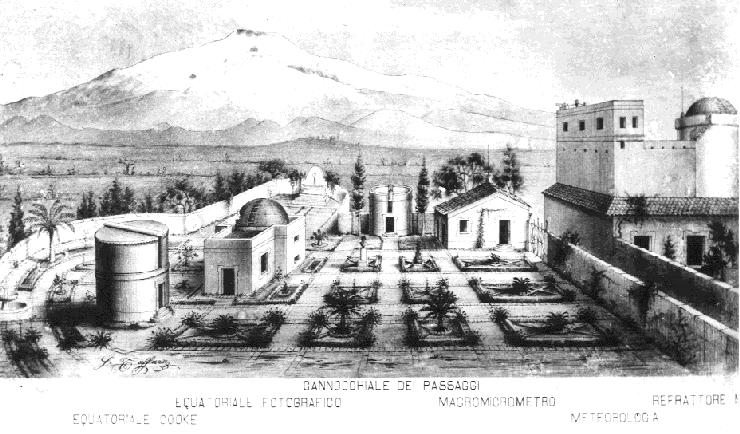
Postcard of the “R. Observatory of Catania and Etna”
Almost at the same time, the first position as professor of Physical Astronomy was established in Catania and it was granted to Prof. Annibale Riccò, who also held the role of first Director of the Observatory.
The period from 1890 to 1919 (the year Riccò died) was very prolific, not only because of the beginning of solar observations, but also because of the Observatory’s participation in an impressive international astronomical project promoted by the French Academy, the “Carte du Ciel” (Sky Chart). This project, which lasted about 50 years, involved 18 observatories from all over the world and consisted in a photographic observational campaign with the aim of cataloguing and mapping the positions of millions of stars. The assignment of the Observatory of Catania (the only Italian to participate in the project) actually conditioned its activity for more than half a century, changing the main research address and even determining later the change of the name of the teaching position from “Physical Astronomy” to “Astronomy with Elements of Geodesy”.
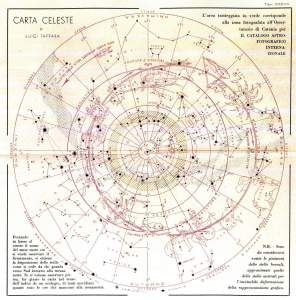
“Carta celeste” by Luigi Taffara. The dashed area corresponds to the area photographed at the Astrophysical Observatory of Catania for the Carte du Ciel. “Il Regio Osservatorio Astrofisico di Catania all’Esposizione Universale di Roma (1942)”, Tav. XXXVII.
Following the decree of the Ministry of Education of December 31, 1923 the royal observatories passed to the direct dependencies of the Ministry itself and so it was also for the Astrophysical Observatory of Catania, but not for the Etna observing station that, more and more abandoned by the astronomers, remained at the University from which, in 1925, was assigned to Volcanology.
A very important figure for the Observatory of Catania, which contributed significantly to the compilation of the Carte du Ciel, was the mathematician of Tuscan origin Azeglio Bemporad. After a first period spent in Catania as assistant astronomer, he became Director of the Observatory in 1934 but unfortunately in ’38 he was removed for the racial laws, being Jewish.
During the alternation of the different Directions, the continuity of the Observatory’s life was ensured by Luigi Gaetano Taffara, since 1901 calculator in the roles of the Observatory. In 1942, during a session of the Accademia Gioenia, Taffara announced the conclusion of the compilation of the Carte du Ciel. This work, however, although immense and of great merit, conditioned a lot the development of new research activities having access to human and economic resources rather limited.
With the background of the Second World War, the following years were dedicated, more than to research and teaching, to the defense of the very existence of the Observatory and to the assurance of the continuity of solar observations that had been regularly conducted, despite the compilation of the photographic catalog, the now obsolete equipment and the structures suffocated by the expansion of the various hospital pavilions and the city, thanks also to the good quality of the sky in Catania.
After overcoming the various difficulties related mainly to the war events, the Observatory found a renewed impetus under the direction of Prof. Mario Girolamo Fracastoro. Thanks to his efforts and to those of his collaborators, the present city seat was realized in the small hill of Santa Sofia near the Cittadella Universitaria and, in the same year (1966) another observing station was inaugurated in Serra la Nave (mt. Etna, 1750 m above sea level). In fact, the “Casina degli Inglesi” on Etna was used as observing station until 1925, when it was definitively assigned to the Volcanological Institute; moreover the structure was then buried by about 15 meters of lava during the volcanic eruption of 1971. As for the site in San Nicolò La Rena, at the beginning of the 70’s, all the garden and the buildings were given to the “Vittorio Emanuele” Hospital which demolished them to build new hospital pavilions, while the dome was destroyed in 1982 and the astronomical instruments dispersed.
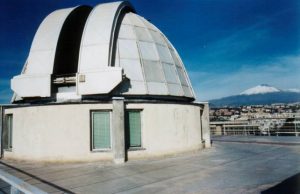
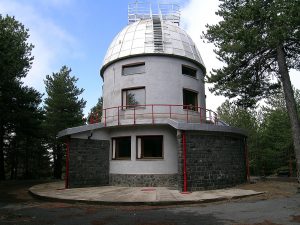
In 1982 the D.P.R. 163 was issued, which established the autonomy of the Observatories and adjusted their administrative structure.
The union between the Observatory and the University of Catania lasted until the 2000s when the Institute of Astronomy no longer had the autonomy to subsist and was finally incorporated by the University, becoming a section of the Department of Physics and Astronomy.
From January 1st 2002, the Astrophysical Observatory of Catania, like all the Italian Observatories, officially became part of INAF (National Institute of Astrophysics) as a permanent structure, with scientific, administrative and financial autonomy, having as primary task the carrying out of fundamental research in the field of astronomy, astrophysics and cosmic physics, technology transfer and education.
Bibliography
Abetti G., “Annibale Riccò, l’Accademia Gioenia e l’Osservatorio Astrofisico di Catania (1966)”, Bollettino Accademia Gioenia III (1955), Serie IV, Fasc. I, p. 13 in Pubblicazioni Osservatorio Astrofisico di Catania 1-25
Blanco C., “L’accademia degli astronomi”, in L’Accademia Gioenia. 180 anni di cultura scientifica (1824-2004), a cura di Mario Alberghina, Catania 2005, pp. 171-177
Blanco C., “Quali le modalità per la nomina a Direttore dell’Osservatorio Astrofisico di Catania”, Bollettino Accademia Gioenia 52 (2019)
Blanco C., “Tacchini e l’astrofisica a Catania”, Giornale di Astronomia 4 (2005), p. 31
Chinnici I. / Blanco C. “L’Etna e le stelle”, in Atti del XXXIII Convegno annuale SISFA – Acireale, Catania, Siracusa (2013), p. 67 http://www.paviauniversitypress.it/articolo/9788869520495-c04/450
Chinnici I. / Gasperini A. Alle origini dell’astrofisica italiana. Il carteggio Secchi-Tacchini 1861-1877, Firenze 2013
Cristaldi S. / Mangano A., “The Astrophysical Observatory and the University Institute of Astronomy in Catania”, Memorie della Società Astronomica Italiana 66 (1995), p. 785
Cristaldi S., “L’Osservatorio Astrofisico di Catania dalla sua fondazione ad oggi”, Coelum 50 (1982), p. 139
Cristaldi S. / Mangano A. / Rodonò M., “Contributo dell’Osservatorio Astrofisico di Catania al Progetto della Carte du Ciel”, Atti del Convegno Annuale di Storia dell’Astronomia, Cagliari 24/25 settembre 1999, in Storia del servizio internazionale delle latitudini e delle imprese di cooperazione internazionale (1850-1950) & Astronomia e Archeoastronomia, a cura di Pino Caledda / Edoardo Proverbio, Cagliari 1999, pp. 133-143
Cutispoto G. / Mangano A., “A Catania le stelle brillano sul vulcano”, Le Stelle 109 (2012), p. 62
Domina D., “Bellini, l’Etna e l’astronomia”, Giornale di Astronomia 1 (2021), p. 44
Foderà Serio G. / Randazzo D., Astronomi italiani dall’unità d’Italia ai nostri giorni. Un primo elenco, Firenze 1997
Foderà Serio G. / Piazzi G., Sulle vicende dell’astronomia in Sicilia, Sellerio, Palermo 1990
Foderà Serio G. / Mandrino A., Progetto Nazionale per il riordino degli Archivi degli Osservatori Astronomici ed Astrofisici, Ministero per i Beni e le Attività Culturali, UCBA, Società Astronomica Italiana, Consorzio Nazionale per l’Astronomia e per l’Astrofisica, s.l.1999
http://www.archivistorici.inaf.it/doc/specola2000.pdf
Fracastoro M. G., “Attività dell’Osservatorio Astrofisico di Catania dal marzo 1954 al giugno 1956”, Bollettino Accademia Gioenia III (1956), Serie IV, Fasc. 5, p. 199, in Pubblicazioni Osservatorio Astrofisico di Catania Nuova Serie 1-25
Fracastoro M. G., “Attività dell’OAC dal luglio 1956 al dicembre 1959”, in Pubblicazioni Osservatorio Astrofisico di Catania Nuova Serie 1-25
Fracastoro M. G., “Per una nuova sede dell’Osservatorio astrofisico di Catania”, Atti Accademia Gioenia, X (1955), Serie VI, p. 99, in Pubblicazioni Osservatorio Astrofisico di Catania Nuova Serie 1-25
Fracastoro M. G. “Attività dell’OAC durante il 1960” in Pubblicazioni Osservatorio Astrofisico di Catania Nuova Serie 26-50
Fracastoro M. G., “La sede stellare dell’Osservatorio Astrofisico di Catania a Serra La Nave” in Pubblicazioni Nuova Serie 107 (1967)
Godoli G., “Attività dell’O.A.C.” in Pubblicazioni Nuova Serie 118 A (1967)
Maccarrone G. D. / Recami E. “Storia dell’Astronomia a Catania” in Bollettino Accademia Gioenia in Scienze Naturali, 19 (1986), pp. 5-37
Mangano A., “Storia di Azeglio Bemporad: astronomo, poeta, ebreo”, Giornale di astronomia 41 (2015) http://www.libraweb.net/articoli.php?chiave=201508802&rivista=88
Riccò A., Il R. Osservatorio Astrofisico di Catania all’esposizione universale di Roma, 1890-1940, Catania 1940
Poppi F. / Bonoli F. / Chinnici I., “Il progetto Tacchini e la riforma degli Osservatori italiani” in Cento anni di astronomia in Italia 1860-1960. Convegno per il 4° centenario della fondazione dell’Accademia dei Lincei, Roma 2003, pp. 123-148
Prestinenza L. “L’Osservatorio Astrofisico di Catania” Nuovo Orione (1994), p.32
Provini L., “Seconda stella a destra questo è il cammino … L’osservatorio astronomico di Catania (1850-1920)” – Tesi di Laura A.A. 2015-16 (UNICT – Dip. di Scienze Politiche e Sociali)
Tacchini P., “Una gita all’Etna”, Memorie della società degli spettroscopisti italiani (1876), p. 151
Tacchini P., “L’Osservatorio dell’Etna”, Memorie della società degli spettroscopisti italiani (1877), p. 75
Tacchini P., “Della convenienza e utilità di erigere sull’Etna una stazione astronomico-meteorologica”, Atti dell’Accademia Gioenia di scienze naturali in Catania (1878), p. 7
Contatti
Osservatorio Astrofisico di Catania
Via Santa Sofia 78, 95123 Catania, Italia
(+39) 095.7332111
segreteria.direzione.oact@inaf.it
(PEC): inafoacatania@pcert.postecert.it
Per informazioni sul nostro sito: web.oact@inaf.it
Per informazioni sulla didattica e divulgazione: divulgazione.oact@inaf.it